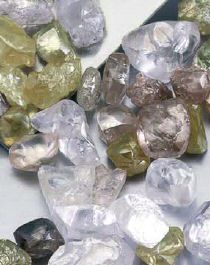IDEX Online Rough Diamond Market Report: Banks and Traders Try to Cut Prices
September 10, 13
 |
Of course, the banks did not say this outright, but used the main power at their disposal – halting financing – and used it with force. After analyzing their clients' borrowing, polished diamond receivables and rough diamond expenditures, three important banks, State Bank of India (SBI), ABN AMRO and Antwerp Diamond Bank (ADB), decided to limit their clients’ ability to buy rough diamonds, specifically from De Beers.
Ahead of the last Sight, SBI told its clients ' it would not give Sightholder clients 'credit to buy rough diamonds from De Beers. ABN AMRO told its Sightholder clients that it was limiting financing to 80 percent (and in some instances to 70 percent) of Sight purchases instead of giving the usual 100-percent financing.
In addition, ADB is currently reviewing its rough diamond financing policies for all first-hand buyers, those who purchase goods directly from diamond mining companies, including purchases from De Beers and Alrosa. The bank is considering the implementation of a similar policy to ABN AMRO’s – decreasing the amount of financing.
The overriding concern among these and other banks providing financing to the global diamond industry is that diamond manufacturers may become non-profitable because of the high rough prices and the difficulties first-hand buyers have in refusing goods from diamond producers. This difficulty results from a combination of contractual obligations and concerns about appearing weak and unable to pay for the goods.
The goal of the banks is to force diamond miners, specifically De Beers and Alrosa, to decrease prices by making it harder for large manufacturers to buy the goods. Without the support of the banks, they must either turn down the diamond supplies, or finance at least some of the purchases directly from their own pocket. Either way, the banks are decreasing their own exposure.
The move, which was quietly welcomed by Sightholders at the last Sight, has had some short-term success. De Beers realized that traders’ constant grumbling about the high prices was not a negotiation tactic, and has reduced the price of about two thirds of the diamond boxes. The overall decrease, however, was not substantial, estimated at about 1.5 percent on average.
Boxes that had their prices substantially reduced include Makeable Cubes -3grs/+7 that was reduced by about 6.7 percent to $155 per carat (p/c); the Fine Collection Z 4-8grs that were offered for $1,226 p/c after a 3.8-percent price reduction and 2.5-4 carats Crystals, lowered by 5.7 percent to $2,661 p/c.
At the same time, some boxes saw a price increase – in some cases significant. For example, the price of the Commercial High 5-14.8 carats box was hiked by 2.3 percent to $3,657 p/c and the price of the Commercial High Select Makeable 5-14.8 carats was increased a noticable 6.4 percent to $2,540.23 p/c.
The low price decline comes in addition to the relatively large Sight. The total value of the Sight was estimated at $600 million. By comparison, the June Sight was estimated at $550 million.
Alrosa, the second largest producer by value, has followed suit, and took it a step further. The Russian diamond miner has lowered prices on average by about three percent. By doing this, Alrosa not only responded to market changes, it did so in a meaningful way.
Following the June Sight, we quoted a passage from the Talmud that says, “More than the calf wants to suckle, the cow wants to nurse.” We wrote then, “Today’s rough diamond market is a good example of this: the miners want to feed manufacturers rough more than the manufacturers want to buy it. As a result, goods are trading at low prices and many goods are left unwanted.”
Today, when not only the Sightholders, but also their financing institutions do not want to back the goods, miners need to face the realities of the market. Sightholders tried to delay deliveries of goods (via the ITO – Intention To Offer schedule) and bought very little Ex-Plan, although Specials – goods weighing 10.8 carat or more – were offered and picked up. These items are less sensitive to fluctuations in market demand.
The backdrop to the low demand for rough diamonds is the sluggish polished diamond market. The IDEX Online Polished Diamond Price Index declined 1.9 percent in August, losing nearly an entire percentage point compared to July.
Another issue that is causing resistance to rough-diamond buying is an apparently huge stock of polished, estimated by some at well over $1.5 billion.
Naturally, with less demand for rough, low demand for polished and a large inventory on the shelf, the secondary rough market is reluctant to pay a premium on top of the current high De Beers and Alrosa prices. Currently, buyers are willing to pay about list price for the goods, which means an outright loss for Sightholders and contracted Alrosa clients.
Outlook
With constricted bank financing, high polished diamond inventories and only two months until Diwali, a time when the diamond industry in India, including the manufacturing sector, goes on vacation, demand for rough diamonds is not expected to show a significant pick up.
If the diamond financing banks continue their pressure and manufacturers resist the urge to buy rough goods, prices of rough diamonds are set to decline, possibly by a mid-single digit. In such a scenario, manufacturers will see the possibility of profitability and may in turn reduce prices of polished diamonds. This could spark renewed interest on the part of retailers, not to mention a turnover worth working for.